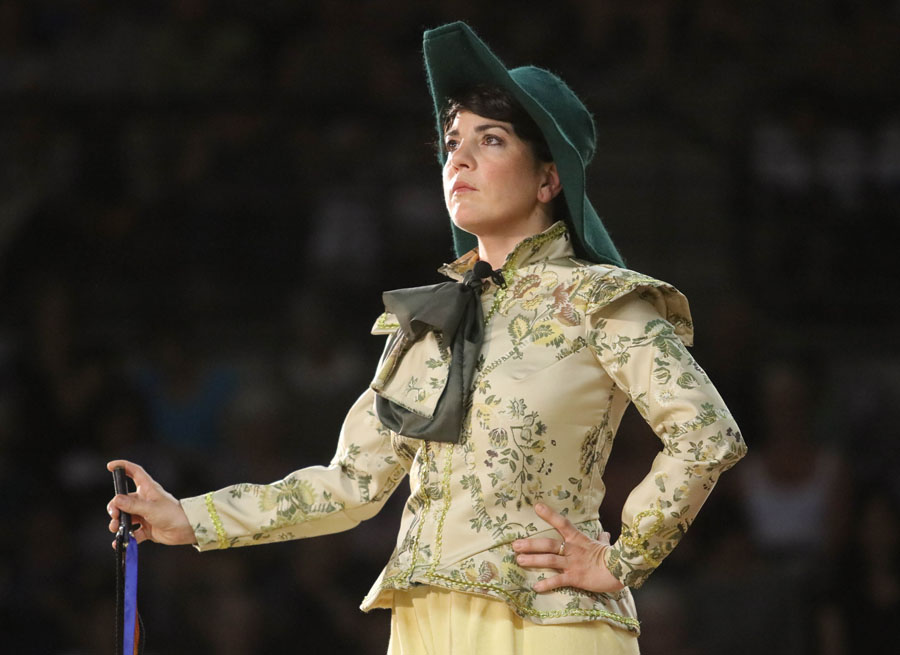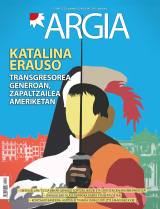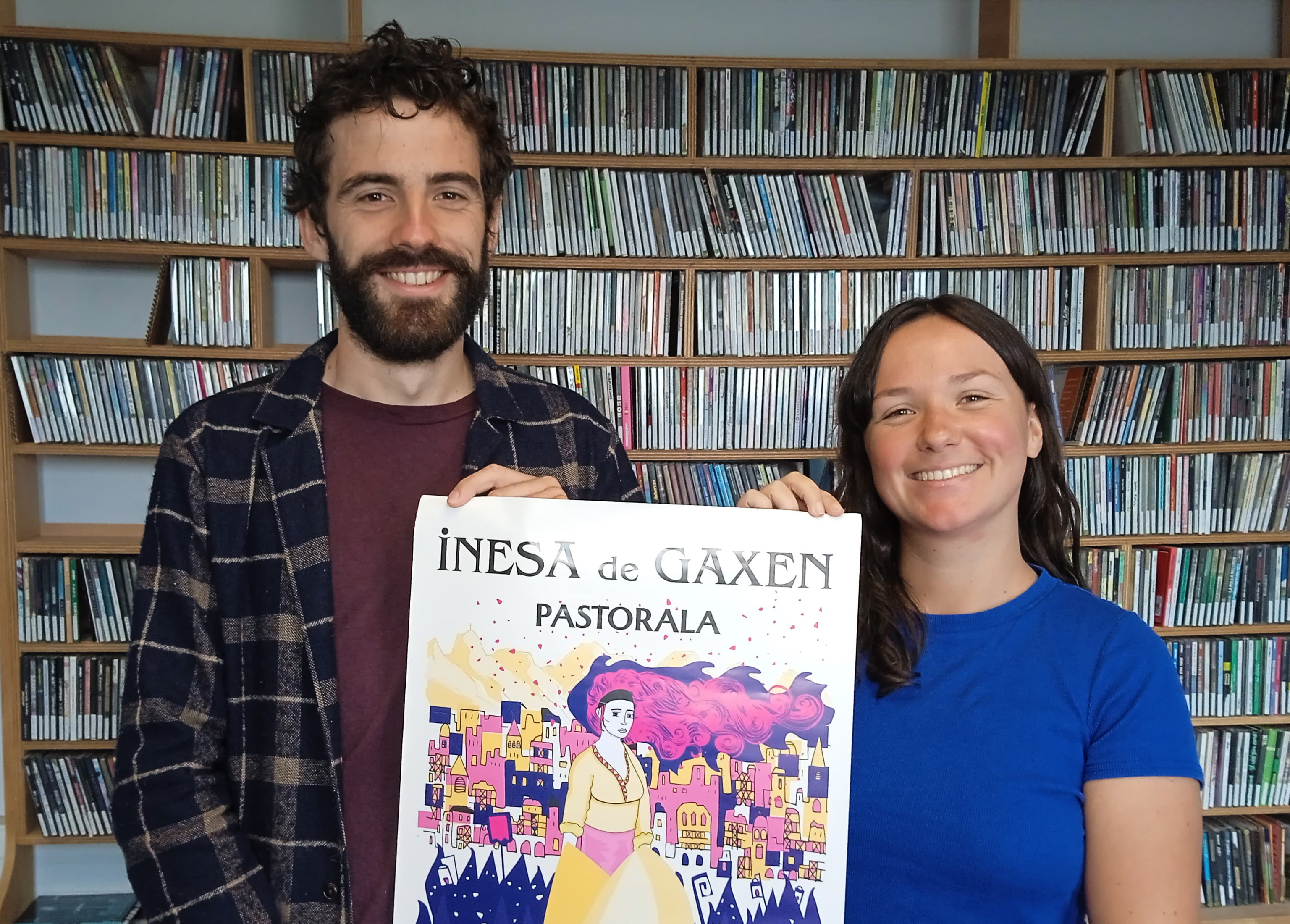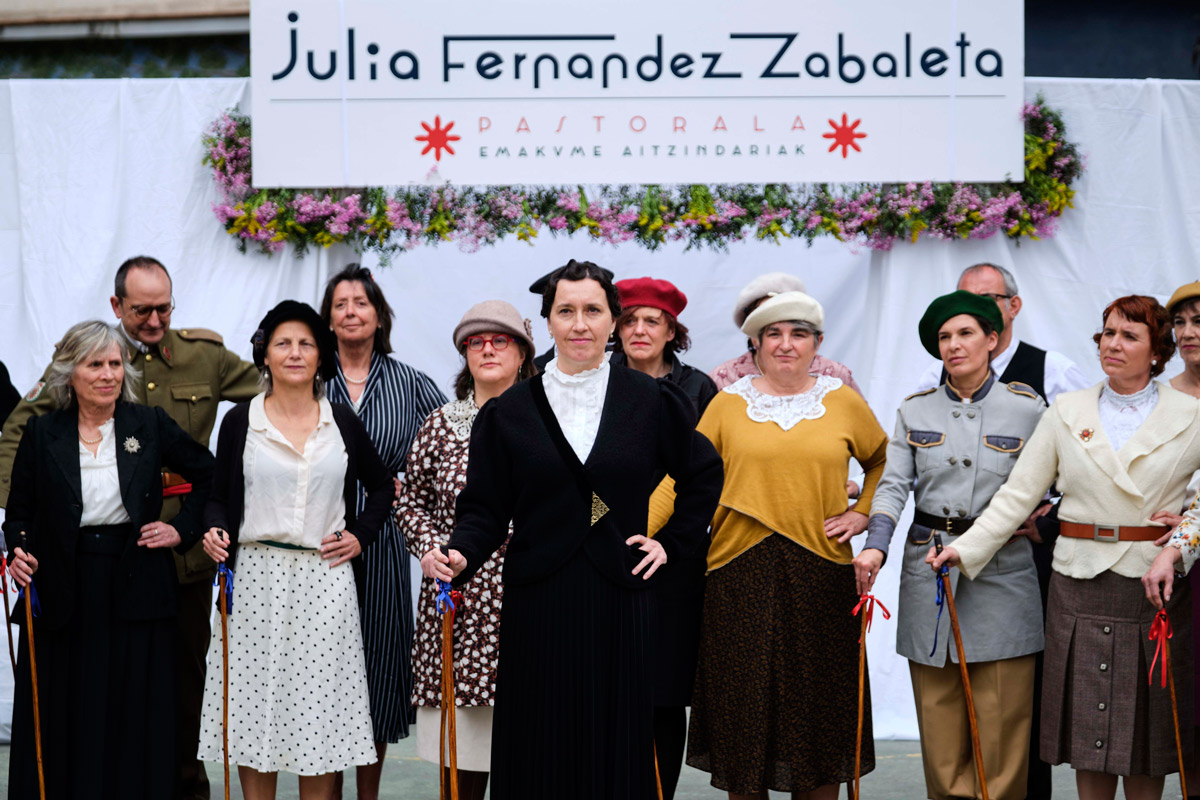Hidden character on stage
- 17th century. The adolescent has escaped from the Dominican convent of Donostia-San Sebastian by her home in a prison. It goes to America to fight for the king of Spain, to crush its inhabitants. He has been dancing the sword in the New World for twenty-five years. It's not a man, it's a woman. It's no longer Katalina Erauso, the adventurer from Donostia Francisco Loyola in a man's suit. The controversial character of many faces, better known outside the home than at home, has been brought to pastoral care. After the recital of Baiona, the work will be represented in the scenes of San Sebastian and Donibane Garazi.

Maite Berrogain was in charge of updating Katalina Erauso in 2005. Catalina de Florance Delay: He read the book Enquete and thought he had found a wrestling woman who was foreign and famous in the world. This character had many elements: army, church, fights, being a woman, doubts about sexual orientation... that is, it seemed an excellent material to make pastoral.
Eleven years later, in Baiona, on 5 June, 3,000 people, overwhelmed by the sports club Lauga, were able to enjoy the first performance of Katalina Erauso. The viewers forgot the heat and the heat and began to hear the words of the archers. When they found it opportune they applauded, laughed and heard shouts of displeasure. The Victoria Eugenia Theatre in Donostia-San Sebastian will have a capacity for 800 people. Much less public than in Baiona and probably a lot of people from the south who have not become accustomed to seeing pastoral care. Guillaume Irigoyen (Arizalea and Letrista of several songs) has expressed concern about whether viewers will participate in pastoral care properly: “Half of the public in Baiona has participated in some pastoral ministry and the other half wants to participate.”
Recital ‘Katalina de Erauso’
Apparently, in 1624 Erauso began writing the autobiography and was published the following year. It seems like we say it, because according to some more, memory is a story invented by someone.
In the following lines we will tell the adventurous life of Katalina Erauso by taking as narrative thread the speeches and gestures written by Maite Berrogain for pastoral care.
Katalina Erauso was born in San Sebastian in 1592. His father was Captain Miguel de Erauso, a military captain at the service of King Philip III of Spain. María Pérez Galarraga. They had four daughters in four years, and they already had a son. Catherine was a good family.
In the old years, in the
wealthy
families, The girls entered the
convents of Ttipi
The four daughters were introduced into the Dominican convent. Catalina was only four years old. His father did not hide his contempt for his daughters:
Daughters Cost
You to
Family While
Sons Honor You
In Baiona's performance, the attendees did not like their father's attitude at all and the first cries of rejection were heard.
He lived in the convent until he was 15 years old. But I really wanted to get out of there. And turning to the serora, he added:
I don't like the
discipline I like the discipline I have other
desires than me
It was time to leave. He escaped and started a new life, starting to dress like a man.
Biloak dütüt mozüko
(E)ta galtza lüzeak jauntsi
Thus niz hombre üdüri
Gaztea lerden bühürri
I will
leave without Düdarik
in the future Inside dütan
sükarra I will not turn you off again
Francis of Loyola served the court of King Philip IV. I wanted to go to the New World, to America. He crossed Chile, Bolivia, Panama, Venezuela, Argentina and Peru in the area of the sword, in an attempt to collect silver and gold for the king of the Spanish Empire.
He traveled to America with his uncle Egino.
Here jin my rain
Naturally as
you know Everything
to steal silver hurre
Because the boats
are full
of urres This is taking care of the goodness of all
Your job will be
The Dutch did not like the hunger for robbery of the Spaniards:
We cannot satisfy Ürrez the
cold backs of Demabrüe
For a long time
our rotten Spanish enemies
Thefts, fights, swords dances, adventures and escapades were his daily bread in America during his 24 years of life. Sometimes he escaped because he believed that Francisco Loyola was about to be recognized as a woman. Her attitude towards women in men's suits has marked a before and a after in the history of Katalina Erauso. Sometimes it looks like she fell in love with a woman. Maite Berrogain believed he had to do theater continuously so that no one realized he was a woman. In the opinion of others, for example, of some lesbian movements in North America, Erauso liked women.
Here are two stanzas written by Berrogain on this subject:
From
Perun Solarte De
Guild to Guillotte De Perun
Solarte De Guild
Happy to find Hanitx
who's gone to see
Spend time
with girls Work doesn't heal
A little bit of love, but the haters were more raw in America. The spectators of Baiona did not sleep, and again there were cries of reproach in the sports club Lauga, because that is how Catherine’s brother, Migeltxo Erauso, and then Catherine herself spoke:
To destroy the Heben
GütütütüNausi are
the
whites
Indiano bürügorri English
Trumilka will kill
Trumilka to rob
Amalürra
After 24 years of life, she left for Europe and acknowledged that she was a woman and asked the pope to allow her to continue living as a man. His response altered the public, while Erauso’s response was applauded by the public.
First of all, I have to
know whether Heben's two officers, as
they were always virgins,
are going to say yes or no.
A man is not called
Virgin Mary An Engineering
among the
wives of men is that
It did not surrender in Europe. He left again to America, to Mexico,
where he died in 1650.
Donostian, irailaren 3an.
Donibane Garazin, irailaren 10ean.
Idazlea: Maite Berrogain.
Errejentsak:
Pantxika Urruty eta Maitena Lapeyre.
Katalina Erauso:
Alaia Ithurbide, Laida Abadie,
Miren Elkegaray eta Graxiana Castillon.
Zer moduz joan zen Baionako emanaldia?
Enetako izugarri ontsa zeren eta publikoak parte hartu zuen. Zinez, plazer egin dit. Horrek harrapatu nau, ustekabe ona da hala ere.
Donostian publikoa diferentea izango da. Nola erantzungo duela uste duzu?
Nola jakin! Batzuek erraten dute, “Ez da holakorik izanen beste lekuetan”. Bada ez dakit. Pentsatzen dut baietz, zeren eta gorri eta urdinen arteko borroka hor da, emaztetasunaren aldeak… Pentsatzen dut baietz, jendeak pastoralean parte hartuko duela.
Katalina Erausoren historiak pastoralerako osagai guztiak dituela diozu. Erausoren zein aurpegi erakutsi nahi izan duzu?
Lehenik emaztearen gauza. Askatasun gose hori. Emazteak ez dira behar izan komentuan edo ezkondu, bazuten beste asmorik ere, denbora horretako beste emazte batzuek ere. Zeren eta geroztik irakurria dut Kristobal Kolonekin joaten zirenak denak gizonak zirela, eta Pizarro eta Cortesekin emazteak ere joaten ziren konkistarat. Beraz, ez zen hain harrigarria emazteak ikustea, nahiz eta Katalina gizonez emana zen. Hala ere, momentu batzuetan emazte agertu da. Eman dezagun, bere osabaren itsasontzia hartu duelarik bere osabak bazekien emaztea zela.
Aurpegi gehiago ere baditu Erausok.
Borrokazalea. Denbora haietakoa zen konkista. Gaurko egunekoa baldin bazen beste gauza batzuk defendatuko zituen beharbada, ez dakit.Beste aurpegi bat: Emazteen arteko maitasuna. Ezin dugu jakin zuzen ordea, emazteak maite zituenik. Bakoitzak pentsa dezala nahi duena hortaz.
Pasarte batean Erausok emakume batenganako desioa adierazten du.
Egia erran, gizona zela eta emazteak maitatzeko prest zela behar zuen erakutsi. Ez nintzen urrunago joaten ahal.
Antzerkia egin behar zuen gizona zela garbi gera zedin momentu oro.
Nire ustez hori zen, behar zuen komedia bururaino eraman. Pastoralean ez dugu dena eman ahal izan ere. Momentu batez, Andeetako basamortua pasatuta, emazte beltz batek eta bere alabak etxera eraman zuten. Alabarekin ezkontzeko eskatu zion amak. Guk ez dugu agertu, baina testu batean erraten du emaztea hain zela itsusia ez zuela nahi harekin ezkondu. Eta beharbada estakuru bat topatu du, ihes egiteko.
Zaila da jakitea emakumeak desio zituen ala ez.
Hori da. Batzuek ideia hori bereganatu dute, Ipar Amerikako elkarte batzuek, lesbiana mundukoek.
Euskal nortasuna ere bistan da pastoralean.
Izugarrikoa izan da. Hango eliz buruak, epaileak, korrejidoreak, euskaldunak ziren eta elkartasuna adierazten zuten, beti Katalinaren alde. Ez dugu agertu, baina bi aldiz hiltzera kondenatua izan zen eta azken momentuan bazen norbait errateko Katalina bizkaitarra zela eta salbatu behar zela. Beti atera da horrela.
Espainiarra ere bada. Erregearen alde ari da eta konkistatzaile da.
Ez dakit izan zaren Hego Amerikan, baina joaten bazara edozein lekutara denetan badituzu euskal izenak, karriketan, etxeak… Gure historia beltza da. Katalina ere ardi beltza da. Konkistan parte hartu dute euskaldunek Espainiaren eta Frantziaren alde. Euskaldunak zepoan harrapatuta ginen, bien artean.
Donostian bada brontzezko bustoa, kale bat ere bai bere izenarekin, elkarte baten izena... baina Donostiatik kanpo ez da batere ezaguna. Bere historia, ene ustez, gordea izan da.
Gordea izan dela esango zenuke?
Katalinak ez baititu biltzen euskaldunen baloreak. Erraten ahal dut pastoral hori ez dutela sekula emanen Zuberoan. Pertsonaia tradizionaletik kanpo da. Pentsa ezazu pastoral hau zer den adin batekoentzat, batzuek mutur egiten dute Elizako historia aipatzen baita, haserretu dira.
Aita santuak Erauso birjina den jakin behar dela esaten du eta ikus-entzuleek arbuioz erantzun zuten Baionan.
Bai, bai, izugarri.
Sujeta, Katalina Erauso, gorria da. Ohikoa urdina, ona, izatea da.
Gorrietan sarrarazi dugu. Zuberoan ez dute sekula egin, eta ez dakit eginen duten. Uste baldin bada beti ona behar duela izan, beti urdina... ene ustez sujeta ez da beti ona. Izan delarik konkistan, Espainiako armadan, guk gorrietan ezarri dugu eta indarra eman diegu indianoei, maputxeei, beren kexua agertzeko. Batzuentzat, sujeta gorri ematea iraultza da, guri iruditzen zaigu ez genuela beste maneraz egiten ahal.
Aldaketa jendeak ondo hartu duela iruditzen al zaizu?
Batzuk ez dira ohartu ere egin. Batzuk ez dakite sujetak urdina behar duela izan, kode horiek ere ez dakit non diren [barrez ari da], ahozko tradizioa baita. Niri batek erran dit hautsi ditugula kodeak, eta erran dut pozik naizela kodea hautsi badugu.
Ez zaizu inor etorri esanez ez zaiola pertsonaia gustatu.
Ez, horrelakorik ez. Gaurkotasuna du historia horrek, eta denak harritu dira, ez zen ezaguna historia. Baditut ilobak Ipar Amerikan, eta unibertsitatean ikasia zuten, badakite nor den moja militarra, hemen batere ez. Iruditzen zait Euskal Herritik kanpo nahiko ezaguna dela.
XVI. mendearen amaieran Donostian jaio zen Katalina Erauso, La monja Alferez edo The Lieutenant Nun ezizenez ezaguna. Bere autobiografia idatzi eta 1625ean argitaratu zuen Espainiako erregeari egindako zerbitzuaren truke biziarteko pentsioa eskatzeko eta garaiko aita santuari gizon jantzita jarraitzeko baimena lortzeko. Biak eskuratu zituen eta testu horri esker heldu zaigu haren berri.
Moja izan behar zuenak soldadu eta merkatari izatea erabaki zuen, emakume izan behar zuenak gizon bizitzea aukeratu zuen, heterosexual behar zuenak lesbianismoari zirrikitu bat ireki zion, euskaldun behar zuenak espainiar eta mexikar ere izan zen. Horrela bihurtu zen pertsonaia historiko eta mito literario. Donostian Miramarren edo Tabakaleran aurki dezakegu, baina, zenbateraino ezagutzen du euskal jendeak? Nork eta nola eman digu haren berri?
Bizitza ‘liluragarria’ izan zuela errepikatzen da nazioartean berari buruz idatzi diren testuetan. Azken mende aldaketarekin areagotu egin zen bere presentzia argitalpen zientifikoetan eta gerora apaldu den arren urtero idazten dute berari buruz. Testu gehienetan bere genero identitatea eta sexualitatea sailkatu nahian ibiltzen dira eta ohiz kanpoko irudi bat izan zela diote.
Argitalpenen %1 euskaraz idatzitakoak dira. Zergatik idatzi da hain gutxi Erausori buruz bere sorterrian? Zein da euskaraz eraiki den bere irudia? Lau liburu ditugu: antzezlan bat (Erauso Kateriñe, Katalina Eleizegi, 1962); bere autobiografiaren egokitzapen bat (Katalin Erauso, Iñaki Azkune, 1976); biografia dibulgatzailea (Katalina Erauso, Aitor Zuberogoitia, 1997); eta pastorala (Katalina de Erauso, Maite Ithurbide, 2008).
Eleizegiren antzezlanean askatasunaren bila bere ametsa betetzera doan pertsona irudikatzen da. Azkuneren autobiografiaren egokitzapenean “gizon arima eta indarra” zituela eta “beste emakumeak bezalakoa ez zela” esaten da, “gehiegikeriaz eta zoritxarrez betetako bizitza” izan zuela gaineratuz. Zuberogoitiak Erausori buruz diosku “hain emakume indartsua topatzeak” harritu zuela, “baina gehien hunkitu ninduena bere barne borroka izan zen (…) eta etengabe ihesi egoteak sortzen zion tentsioa”. Ithurbidek Erausori buruz hurrengoa dio: “munduan ezaguna den arren hemen ez dutela berari buruz ezer jakin nahi” eta “generoaren afera egungo jendartearen aldarrikapenetako bat d(el)a”.
Sherry Velascok (2000) dioen moduan kultura hegemonikoak Katalina Erauso eraiki, interpretatu eta merkantilizatu egin du, izan ere pertsonaia honek irakurle/ikus-entzuleen beldur eta desirak agerian uzten ditu. Erauso heroi eta arerio gisa irudikatu izan da, nazio, historia eta kultura desberdinen ordezkari; oso aldagarria eta maneiatua izan den pertsonaia da. Garai bakoitzak sexua, generoa eta sexualitatea modu desberdinetan arautzen ditu, baina errealitatea beti da anitza. XXI. mendean hiru eremu hauei malgutasunez eta dinamikoki begiratzeko erronka dugu, normal izateko eguneroko borroka antzuaz jabetu eta denak diferente garela onartzeko garaia badelako.
*”Genero eta nazio identitateak Katalina Eleizegiren antzezlanetan” tesiaren egilea.
The group of singers Oilarrak will celebrate its 30 years with a pastoral ttipi of the priest Matalaz. In 2013, coinciding with the Xiru Festival, an action such as the pastoral Ederlezi, created by Mixel Etxekopar, will take place with song singers and musicians from the... [+]














